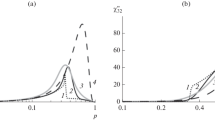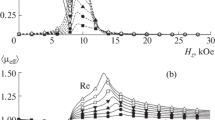Abstract
This paper presents a comparative analysis of the mixture models used in radio physics to describe the effective properties of composite materials and formulates the limits of their applicability and criteria for checking their correctness. Two of the most general models have been chosen, which take into account the transformation of the composite structure upon changes in its composition. The correspondence of the chosen model to the experimental results is considered. The effect of the composite structure on the frequency of the maximum and the shape of its dielectric absorption line is shown. The analysis shows that the complication of the models in comparison with those already known and an increase in the number of parameters determined from the experiment is inappropriate at the existing level of the composition and material parameters (permittivity and permeability) measuring error and due to a significant contribution of the size and surface effects, which is not taken into account in quasi-static mixture models.









Similar content being viewed by others
REFERENCES
C. Bonifasi-Lista and E. Cherkaev, “Electrical impedance spectroscopy as a potential tool for recovering bone porosity,” Phys. Med. Biol. 54, 3063–3082 (2009).
F. Carrique, F. J. Arroyo, M. L. Jimenez, and A. V. Delgado, “Dielectric response of concentrated colloidal suspensions,” J. Chem. Phys. 118, No. 4, 1945–1956 (2003).
P. W. J. Glover, “Archie’s law—a reappraisal,” Solid Earth 7, 1157–1169 (2016).
P. Cosenza, A. Ghorbani, C. Camerlynck, F. Rejibal, R. Guérin, and A. Tabbagh, “Effective medium theories for modeling the relationships between electromagnetic properties and hydrological variables in geomaterials: a review,” Near Surf. Geophys. 7, 563–578 (2009).
G. N. Dul’nev and Yu. P. Zarichnyak, Thermal Conductivity of Mixtures and Composites (Energiya, Leningrad, 1974) [in Russian].
V. I. Loginov and V. G. Kucherov, “Thermal conductivity of homogeneous mixtures,” Prikl. Mekh. Tekh. Fiz. 32, No. 4, 120–125 (1991).
J. G. Berryman, “Effective medium theory for elastic composites,” in Elastic Wave Scattering and Propagation, Ed. by V.K. Varadan and V.V. Varadan (Ann Arbor, 1982).
G. Mavko, T. Mukerji, and J. Dvorkin, The Rock Physics Handbook (Cambridge University, Cambridge, 2009).
J. C. Maxwell Garnett, “Colours in metal glasses and in metallic films,” Philos. Trans. R. Soc. 203, 359–371 (1904).
D. A. G. Bruggeman, “Berechnung verschiedener physikalischer konstanten von heterogenen substanzen, i. dielektrizitätskonstanten und leitfähigkeiten der mischkörper aus isotropen substanzen,” Ann. Phys., 636–664 (1935).
L. Landau and E. Lifshits, Electrodynamics of Continuos Media (Pergamon, New York, 1960).
H. Looyenga, “Dielectric constants of mixtures,” Phys. 31, 401–406 (1965).
V. I. Odelevskii, Candidate’s Dissertation (1947).
J. A. Reynolds and J. M. Hough, “Formulae for dielectric constant of mixtures,” Proc. Phys. Soc. B 70, 769–780 (1957).
A. H. Sihvola, Electromagnetic Mixing Formulas and Applications (The institution of Electrical Engineers, London, 1999), p. 296.
M. Scheller, C. Jansen, and M. Koch, “Applications of effective medium theories in the terahertz regime,” in Recent Optical and Photonic Technologies, Ed. by K. Y. Kim (InTech, 2010), pp. 231–250.
C. Brosseau, “Modelling and simulation of dielectric heterostructures: A physical survey from an historical perspective,” J. Phys. D Appl. Phys. 39, 1277–1290 (2006).
Z. Hashin and S. Shtrikman, “A variational approach to the theory of the effective magnetic permeability of multiphase materials,” J. Appl. Phys. 33, No. 10, 3125–3131 (1962).
D. J. Bergman, “Dielectric constant of a two-component granular composite: A practical scheme for calculating the pole spectrum,” Phys. Rev. 19, No. 4, 2359–2368 (1979).
D. J. Bergman, “Bounds for the complex dielectric constant of a two component material,” Phys. Rev. B 23, 3058–3065 (1981).
R. Pal, Electromagnetic, Mechanical, and Transport Properties of Composite Materials (CRC, 2015).
E. Sancaktar and B. Lan, “Electrically conductive epoxy adhesives,” Polymers 3, 427 (2011).
Ye. P. Mamunya, V. V. Davydenko, P. Pissis, and E. V. Lebedev, “Electrical and thermal conductivity of polymers filled with metal powders,” Eur. Polym. J. 38, 1887–1897 (2002).
K. Ghosh and R. Fuchs, “Spectral theory for two-component porous media,” Phys Rev. B 38, No. 8, 5222–5236 (1988).
C. N. Starostenko and K. N. Rozanov, “Simple calibration method for magnetic permeability measurements in a short-circuited strip cell,” Radiotekh. Electron. 58, No. 10, 1–9 (2013).
E. Tuncer, “Geometrical description in binary composites and spectral density representation,” Materials 3, 585–613 (2010).
A. V. Goncharenko, V. Z. Lozovski, and E. F. Venger, “Lichtenecker’s equation: applicability and limitations,” Opt. Commun. 174, 19–32 (2000).
A. K. Semenov, “On applicability of differential mixing rules for statistically homogeneous and isotropic dispersions,” J. Phys. Commun. 2, 035045 (2018).
S. S. Maklakov, A. N. Lagarkov, S. A. Maklakov, Y. A. Adamovich, D. A. Petrov, K. N. Rozanov, I. A. Ryzhikov, A. Yu. Zarubina, K. V. Pokholok, and D. S. Filimonov, “Corrosion-resistive magnetic powder Fe@SiO2 for microwave applications,” J. Alloys Compd. 706, 267–273 (2017).
S. N. Starostenko, K. N. Rozanov, A. O. Shiryaev, and A. N. Lagarkov, “A technique to retrieve high-frequency permeability of metals from constitutive parameters of composites with metal inclusions of arbitrary shape, estimate of the microwave permeability of nickel,” PIER M. 76, 143–155 (2018).
S. N. Starostenko, K. N. Rozanov, A. O. Shiryaev, A. N. Lagarkov, and A. N. Shalygin, “Determination of sendust intrinsic permeability from microwave constitutive parameters of composites with sendust spheres and flakes,” J. Appl. Phys. 121, 245107 (2017).
K. N. Rozanov, D. A. Petrov, A. N. Maratkanova, A. A. Chulkina, and C. F. Lomayeva, “Microwave properties of powders produced by high-energy milling of iron with paraffin,” Phys. Met. Metallogr. 115, 642–649 (2014).
P. A. Kuznetsov, M. V. Staritsyn, E. A. Samodelkin, and V. N. Klimov, “Study of radioengineering parameters of powders of an AMAG-200 amorphous soft magnetic alloy,” Phys. Met. Metallogr. 119, 436–440 (2018).
E. Meyer, H. Scmitt, and H-Y. Severin, “Dielektrizitatskonstante und Permeabilitat kunstlicher Dielectrica bei 3 cm Wellenlange,” Z. Phys. 8, 257–263 (1956).
S. N. Starostenko and K. N. Rozanov, “Microwave screen with magnetically controlled attenuation,” Prog. Electromagn. Res. 99, 405–426 (2009).
A. N. Lagarkov and K. N. Rozanov, “High-frequency behavior of magnetic composites,” J. Mag. Magn. Mater. 321, No. 14, 2082–2092 (2009).
F. Ollendorff, “Magnetostatik der Massekerne,” Arch. f. Eledtrotech. 25, 436–447 (1931).
D. Polder and J. H. van Santen, “The effective permeability of mixtures of solids,” Physica 12, 257–270 (1946).
C. J. Das and D. K. Das-Gupta, “Inorganic ceramic/polymer ferroelectric composite electrets,” IEEE Trans. Dielectr. Electr. Insul. 3, 706–734 (1996).
Y. Rao, J. Qu, T. Marinis, and C. P. Wong, “A precise numerical prediction of effective dielectric constant for polymer-ceramic composite based on effective-medium theory,” IEEE Trans. Compon. Packag. Technol. 23, 680 (2000).
O. Wiener, “Der Abhandlungen der Mathematisch-Physischen Klasse der Konigl,” Sachsischen Gesellschaft der Wissenschaften 32, 509 (1912).
R. Moore, “Development of a volume fraction scaling function for demagnetization factors in effective media theories of magnetic composites,” AIP Adv. 9, 015115-14 (2019).
W. T. Doyle and I. S. Jacobs, “Effective cluster model of dielectric enhancement in metal-insulator composites,” J. Appl. Phys. 71, No. 8, 3927 (1992).
S. N. Starostenko, K. N. Rozanov, V. Bovtun, and A. O. Shiryaev, “A mixing formula accounting for inversion of matrix structure,” AIP Adv. 10, 015115 (2020).
M. H. Boyle, “The electrical properties of heterogeneous mixtures containing an oriented spheroidal dispersed phase,” Colloid Polym. Sci. 263, 51–57 (1985).
A. Sihvola, “Dielectric polarization and particle shape effects,” J. Nanomater. (2007). https://doi.org/10.1155/2007/45090
A. Moroz, “Depolarization field of spheroidal particles,” J. Opt. Soc. Am. B 26, 517–527 (2009).
W. R. Tinga, W. A. G. Voss, and F. Blossey, “Generalized approach to multiphase dielectric mixture theory,” J. Appl. Phys. 44, No. 9, 3897–3902 (1973).
R. W. Sillars, “The properties of a dielectric containing semiconducting particles of various shapes,” J. Inst. Electr. Eng. 80, 378–394 (1937).
C. J. F. Bottcher, Theory of Electric Polarization (Elsevier, Amsterdam, 1973), p. 377.
E. H. Kerner, “The elastic and thermoelastic properties of composite media,” Proc. Phys. Soc. Sect. B 69, 808–813 (1956).
T. Hanai, “Dielectric theory on the interfacial polarization for two phase mixtures,” Bull. Inst. Chem. Res. 39, 341–367 (1961).
K. Lichtenecker and K. Rother, “Die herleitung des logarithmischen mischungsgesetzes aus allgemeinen prinzipien der stationären strömung,” Phys. Zeitschr. 32, 255–260 (1931).
M. Rother, Über das Konkurrenzverhalten von Dielektrika bei der Mikrowellenerwärmung (KIT, 2010), p. 196.
A. Hunt and R. Ewing, Percolation Theory for Flow in Porous Media (Springer, Switzerland, 2005).
G. C. Topp, J. L. Davis, and A. P. Annan, “Electromagnetic determination of soil water content: Measurement in coaxial transmission lines,” Water Resour. Res. 16, 574–582 (1980).
H. M. Musal, J. H. T. Hahn, and G. G. Bush, “Validation of mixture equations for dielectric-magnetic composites,” J. Appl. Phys. 63, No. 8, 3768–3770 (1988).
L. Yuan, B. Wang, Y. Xu, and Q. Wu, “Calculating the effective permittivity and permeability of composites based on the dilution process model,” Adv. Comp. Lett. 25, 189–193 (2017).
C. Boned and J. Peyrelasse, “Some comments on the complex permittivity of ellipsoids dispersed in continuum media,” J. Phys. D: Appl. Phys. 16, 1777–1784 (1983).
A. L. Garner, G. J. Parker, and D. L. Simone, “Predicting effective permittivity of composites containing conductive inclusions at microwave frequencies,” AIP Adv. 2, 032109-6 (2012).
V. A. Markel, “Introduction to the Maxwell Garnett approximation: tutorial,” J. Opt. Soc. Amer. A 33, No. 7, 2237–2255 (2016).
S. S. Jamaian and T. G. Mackay, “On limitations of the Bruggeman formalism for inverse homogenization,” J. Nanophoton. 4 (2010). https://doi.org/10.1117/1.3460908
A. E. Bussian, “Electrical conductance in a porous media,” Geophysics 48, 1258–1268 (1983).
A. Sihvola, “Homogenization principles and effect of mixing on dielectric behavior,” Photon. Nanostruct. Fund. Appl. 11, 364–373 (2013).
K. N. Rozanov, M. Y. Koledintseva, and J. Drewniak, “A mixing rule for predicting frequency dependence of material parameters in magnetic composites,” J. Magn. Magn. Mater. 324, 1063–1066 (2012).
D. S. McLachlan, A. Priou, I. Chenerie, E. Isaac, and F. Henry, “Modeling of the permittivity of composite materials with a general effective medium equation,” Waves Appl. 6, 1099–1131 (1992).
M. F. Causley and P. G. Petropoulos, “On the time-domain response of Havriliak–Negami dielectrics,” IEEE Trans. Ant. Prop. 61, 3182–3189 (2013).
E. Cherkaev and D. Zhang, “Coupling of the effective properties of a random mixture through the reconstructed spectral representation,” Physica B 338, 16–23 (2003).
R. Simpkin, “Derivation of Lichtenecker’s logarithmic mixture formula from Maxwell’s equations,” IEEE Trans. Microwave Theory Tech. 58, No. 3, 545–550 (2010).
E. Cherkaev, M.-J. Ou Yvonne, “Dehomogenization: reconstruction of moments of the spectral measure of the composite,” Inverse Probl. 24, 065008–065017 (2008).
S. F. Lomaeva, A. N. Maratkanova, A. V. Syugaev, K. N. Rozanov, and D. A. Petrov, “Structural-phase composition, structure of the surface, magnetostatic and microwave properties of powders produced by milling of Fe in polystyrene with additions of surfactants,” Phys. Met. Metallogr. 116, No. 8, 760–767 (2015).
H. Heuermann and B. Schiek, “Procedures for the determination of the scattering parameters for network analyzer calibration,” IEEE Trans. Inst. Meas. 42, No. 2, 528–531 (1993).
Funding
The partial support by the Russian Foundation for Basic Research (project no. 20-52-53020) is acknowledged.
Author information
Authors and Affiliations
Corresponding author
Additional information
Translated by E. Chernokozhin
Rights and permissions
About this article
Cite this article
Starostenko, S.N., Rozanov, K.N. & Lagar’kov, A.N. Electrical and Magnetic Properties of the Binary Heterogeneous Mixture Model. Phys. Metals Metallogr. 122, 323–344 (2021). https://doi.org/10.1134/S0031918X21040104
Received:
Revised:
Accepted:
Published:
Issue Date:
DOI: https://doi.org/10.1134/S0031918X21040104




